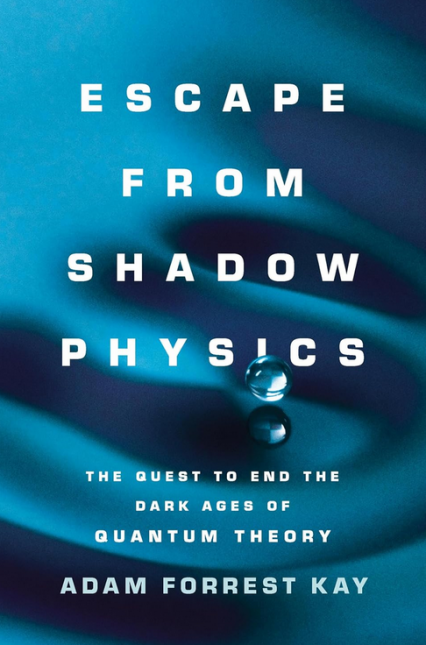Escape from Shadow Physics: The Quest to End the Dark Ages of Quantum Theory
- By Adam Forrest Kay
- Basic Books
- 496 pp.
- Reviewed by Stephen Case
- July 19, 2024
A (mostly) clear look at an awfully murky field.

The analyzing of atoms began in the early 1900s, but classical physics couldn’t explain some of the observed data. Stumped and consternated, theoretical physicists including Niels Bohr, Max Born, Werner Heisenberg, and Erwin Schrödinger rolled up their sleeves and, by the late 1920s, invented a new field: quantum mechanics. “Never…has there been a theory so successful [as] quantum mechanics in…predicting phenomena at the microscopic level,” reports Adam Forrest Kay in his amiable, engaging Escape from Shadow Physics: The Quest to End the Dark Ages of Quantum Theory.
Despite the theory’s success, however, mysteries and controversies remain. The “best summary of quantum physics,” writes Kay, “[is these] five words: ‘Don’t look: wave. Look: particle.’” The phrase refers to the cryptic double-slit experiment used to determine whether electrons are waves or particles. The shocker? When humans are not observing, this experiment reveals electrons to be waves. But when they are observing? Electrons are particles. (For a clever and convincing demo, see Jim Al-Khalili’s video on YouTube.)
Nobel Prize winner Richard Feynmann said the two-slit experiment is “impossible…to explain in any classical way,” yet many physicists couldn’t care less about such quantum puzzles. When newbie students ask skeptical questions, in fact, some professors in the field allegedly bark, “Shut up and calculate!” Their reasoning? “[W]e cannot do better than the probabilities…even in theory,” Kay says. “The…hidden variables that would [explain what is happening] do not even exist.”
In other words, these scientists believe the field of quantum mechanics is whole and complete, but great minds don’t always think alike. To wit, Bohr, a hot-blooded adherent to the completeness doctrine, insisted that searches for unobservable “hidden variables” wasted time. Albert Einstein, on the other hand, scoffed at completeness, calling it the “Heisenberg-Bohr tranquilizing philosophy — or religion?”
Taking Einstein’s side, Kay devotes much of Escape from Shadow Physics to challenging the very notion of completeness. An uncowed disbeliever, he declares his “book is about dissent…damn the torpedoes, full speed ahead!” With dual doctorates from Oxbridge, the author has the credibility to do just that. Permeating this agreeably readable work are his boundless curiosity, mastery of physics, and command of science history (the short bios of famous scientists peppering the text reveal this broad grasp).
The ever-careful Kay succinctly describes experiments involving small droplets that mimic quantum behaviors but suggest classical-physics explanations. This line of inquiry promises (maybe) to expose the so-called “hidden variables,” but not quite yet.
Quantum mechanics, addressing teensy-weensy phenomena (e.g., electrons), “is…irreducibly statistical,” he states. “It gives…probabilities only.” Hence, an electron can be found only in a “wave function”; its presence reveals itself when the wave has “collapsed.” Even so, once an electron is located, its speed cannot be known. Writes Kay:
“Statistical theories are common…[Nobody can model] most real-world things…with full precision. Examples are…stock prices, insurance risks…consumer demographics…and on and on. In…these examples…probabilities emerge as higher-order patterns generated by physical structures [too complex] to reason about at their causal level.”
Got that?
Only in quantum mechanics do no underlying physical structures exist, Kay says. “Put into a formula: every statistical theory comes from mechanism, except for quantum theory which comes from magic.” Nevertheless, he is hopeful that when “future generations look back…[on] our century-long assumption [of completeness, they will call it] lunacy on a civilizational scale.”
The book also reports Kay’s assessment of “science fiction in mathematical form,” i.e., amplifications of quantum concepts to explain literally everything. Quantum mechanics stems from a wave-function “equation that works, but why it works is a mystery.” Regardless, claims that the entire universe is but one grandiose wave function have “effloresced” into the following notions (among others) about the whole shebang, which Kay helpfully lays out in a chart:
|
Interpretation |
Oversimplified formula |
|
Copenhagen |
The moon is not there when nobody looks at it. |
|
Many Worlds |
An entirely new universe is created each time something happens. |
|
Von Neumann-Wigner |
The mind creates the physical world. |
|
Consistent Histories |
The universe has more than one past. |
|
Relational |
Objects are not real, but their relationships are. |
|
Transactional |
The future affects the past. |
Still, the author has reservations about some of the more far-fetched ideas above, and readers may, too. Of interest to anyone seeking further edification might be “A Brief History of Quantum Mechanics” by the urbane, learned Sean Carroll (himself a “Many Worlds” proponent).
It’s all fun, heady stuff, but who’s correct? Stay tuned.
Stephen Case is a member of the Independent’s board of directors and serves as its treasurer.

